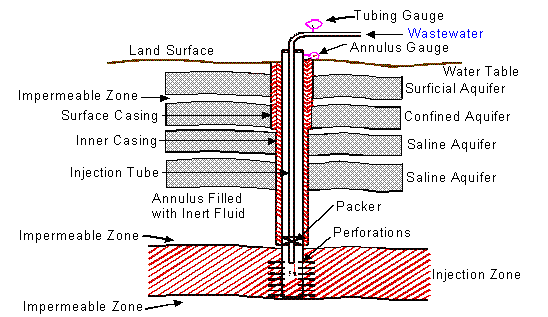Deepwell Injection...
Description...
Deep well injection is a liquid waste disposal technology. This alternative uses injection wells to place treated or
untreated liquid waste into geologic formations that have no potential to allow migration of contaminants into potential
potable water aquifers.A typical injection well consists of concentric pipes, which extend several thousand feet down from
the surface level into highly saline, permeable injection zones that are confined vertically by impermeable strata. The
outermost pipe or surface casing, extends below the base of any underground sources of drinking water (USDW) and is cemented
back to the surface to prevent contamination of the USDW. Directly inside the surface casing is a long string casing that
extends to and sometimes into the injection zone. This casing is filled in with cement all the way back to the surface in
order to seal off the injected waste from the formations above the injection zone back to the surface. The casing provides
a seal between the wastes in the injection zone and the upper formations. The waste is injected through the injection tubing
inside the long string casing either through perforations in the long string or in the open hole below the bottom of the
long string. The space between the string casing and the injection tube, called the annulus, is filled with an inert,
pressurized fluid, and is sealed at the bottom by a removable packer preventing injected wastewater from backing up into
the annulus.

Applicability and Limitations...
The target contaminant groups for deep well injection are VOCs, SVOCs, fuels, explosives, and pesticides. However, existing
permitted deep well injection facilities are limited to a narrow range of specific wastes. Success at expanding existing
permits to manage hazardous wastes seems unlikely. Factors that may limit the applicability and effectiveness of these
processes include ;
- Injection will not be used for hazardous waste disposal in any areas where seismic
activity could potentially occur.
- Injected wastes must be compatible with the mechanical components of the injection well
system and the natural formation water. The waste generator may be required to perform
physical, chemical, biological, or thermal treatment for removal of various contaminants
or constituents from the waste to modify the physical and chemical character of the waste
to assure compatibility.
- High concentrations of suspended solids (typically >2 ppm) can lead to plugging of
the injection interval.
- Corrosive media may react with the injection well components, with injection zone
formation, or with confining strata with very undesirable results. Wastes should be
neutralized.
- High iron concentrations may result in fouling when conditions alter the valence state
and convert soluble to insoluble species.
- Organic carbon may serve as an energy source for indigenous or injected bacteria
resulting in rapid population growth and subsequent fouling.
- Waste streams containing organic contaminants above their solubility limits may require
pretreatment before injection into a well.
- Site assessment and aquifer characterization are required to determine suitability of
site for wastewater injection.
- Extensive assessments must be completed prior to receiving approval from regulatory
authority.



